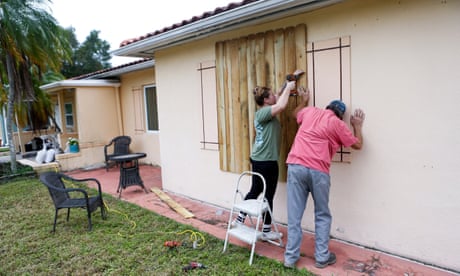Category 5 Hurricane Milton is expected to double its wind field by the time it makes landfall in the US late Wednesday or early Thursday, with up to 15ft (4.5 meters) of storm surge along a low-lying stretch of the Florida coast that includes the cities of Tampa, St Petersburg, and Sarasota.
Described as the “storm of a century”, with sustained winds still registering at 160mph (257km/h), Milton turned north-east overnight about 300 miles (480km) southwest of Tampa, aiming for heavily populated and highly vulnerable communities. It is expected to weaken slightly when it makes landfall to a category 4 with sustained wind speeds of about 130mph.
“Milton has the potential to be one of the most destructive hurricanes on record for west-central Florida,” the National Hurricane Center warned.
In an 8 am update, the governor of Florida, Ron DeSantis, said it was not clear exactly where the eye of the storm would come ashore but the impact would be “broader than that … absolutely every place on the west coast of Florida could get major storm surge.”
“If you are in a single-story home that is hit by a 15ft storm surge, which means that water comes in immediately, there’s nowhere to go,” said the mayor of Tampa, Jane Castor.
“So if you’re in it, basically that’s the coffin that you’re in.”
Authorities have issued mandatory evacuation orders across 11 Florida counties with a combined population of about 5.9 million people and said anyone choosing to stay behind must fend for themselves.
Under current projections, the surge is expected to hit Fort Myers Beach, an area still recovering from Hurricane Ian two years ago that smashed a causeway to outlying islands.
Efforts to protect property with sandbags and by boarding up windows had been made “with the knowledge that this could be the most powerful storm many in this area have ever seen, and they’ve seen plenty”, Gray said.
The National Weather Service warned that as Milton began moving onshore on Wednesday “conditions will be favorable for tornado development, even far away from the expected landfall”.
With area airports now closed, operators said they would not reopen until damage had been assessed. A spokesperson for Tampa International Airport told Scripps News that safety was critical for their operations and it could not act as a shelter for travelers stuck there since it is located in an evacuation zone.
TYT Newsroom



